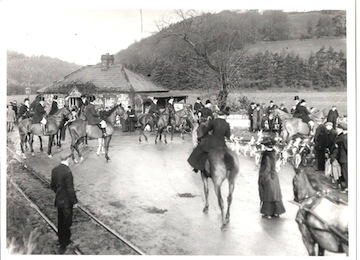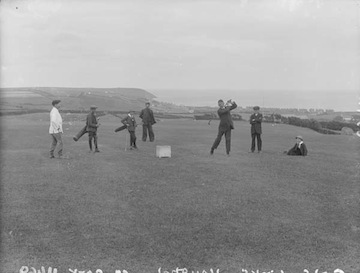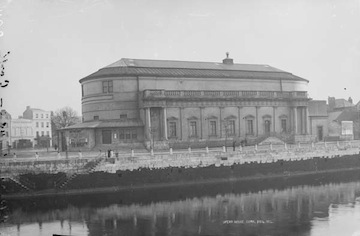Sporting and cultural life in Cork in the early 20th century
View the photo galleryTradition has it that the first steeplechase ever held took place in 1752 when two huntsmen in Cork, Edmund Blake and Cornelius O’Callaghan, raced their horses for a wager, between St. John’s church beside the old castle in Buttevant and St. Mary’s church in Doneraile. This was country where the famed Duhallow hunt was already established. The two men are reputed to have raced for the prize of a cask of wine. There is no record of who won the wager. Horse racing was run by men of a culture which also included shooting and fishing (see Anthony Bishop, gamekeeper to the Earl of Bandon at Castlebernard).
By the second half of the nineteenth century the races at Cork Park in Cork city, which opened in the 1860s, were drawing huge crowds to see horses run for considerable amounts of prize-money. By the 1870s the Great Southern and Western Railway was donating large sums to the race meeting. It was no mere act of altruism. In 1888 the GSWR donated £200 in sponsorship; rail receipts earned by the company from Cork Park meetings reached £700. Racing at Cork Park went through phases of great prosperity and also phases of gloom, when the meetings seemed destined to collapse. By 1911 the number of race meetings had been reduced to three from five, and the level of prize-money had fallen sharply. Its Easter Monday meeting, however, remained its boon fixture. The racecourse closed suddenly in 1917 – the site became the home of the Ford factory – but racing was re-established in the county in 1924 at Mallow, where a racecourse remains to this day.
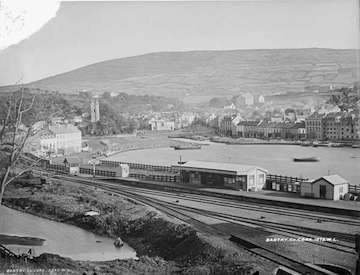
Railway lines run into Bantry ca. 1900. The growth of the railways facilitated an increase in attendances at sporting events. Railway companies sought to identify with such events by offering sponsorship.
(NLI, LROY 01873)
Throughout its existence, Cork Park had been used for many sporting events. Rugby matches were played there in the 1870s. A match in January 1875 saw a team from Montenotte defeat a team from Queen’s College, Cork. There were a variety of rugby clubs around Cork by then, including Cork F.C. and Cork Bankers. The Cork Constitution rugby club was founded in 1892. This was formed from a cricket club which was itself formed by the staff of the Cork Constitution, the old unionist newspaper in the city. The rugby club’s first president was H.L. Tivy of Dundanion. By 1898, four of its players, David Kilroy of South Mall, Moss Landers, E. J. Fitzgerald and Edward McCarthy, had played for Munster, while McCarthy had made it onto an Irish team. When the site of the international exhibition at the Mardyke was redeveloped as a sports facility, Cork Constitution took up residency. In 1911 Ireland played France in a rugby international at the Mardyke. By then University College Cork had taken over the grounds, and Cork Constitution had secured a longterm lease. One of the club’s players, Michael Heffernan of Watercourse Rd., scored a try in a convincing Irish victory.
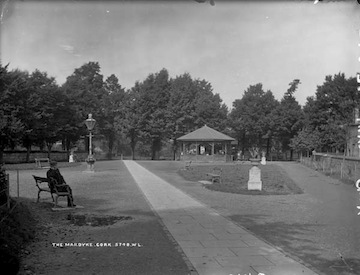
The Mardyke, Cork in the late 19th century. Redeveloped as a sportsground and a home to Cork Constitution, Ireland played France in a rugby international on this site in 1911
(NLI, LROY 05748)
As well as rugby and horseracing, Cork Park had also been the first home to the GAA in Cork. It was in Cork Park that many of the matches in the Cork championships, first played in 1887, were staged, despite complaints that the surface was entirely unsuited to hurling. Cork had been the venue for the second ever meeting of the GAA on 27 December 1884, when Cusack and Davin travelled to a well-attended meeting at the Victoria Hotel in the city. This was recognition of the fact that athletic activity was prominent in the city and that one of the first secretaries of the GAA, John McKay, worked in the city for the Cork Examiner and the Cork Herald newspapers.

The 1908 Hibernians Senior Football Team in London. In the centre with the ball is Sam Maguire, originally from Dunmanway in Cork, with his brothers Dick and Bill to his left.
(http://www.sammaguirehomestead.ie/page/Sam-Maguire.aspx)
Initially, the GAA’s All-Ireland championships were played for by the winning clubs of every county’s local championship. The clubs of Cork, by 1911, had already enjoyed considerable success. Indeed, in 1890 Cork clubs had won both the hurling and the football championships, with Aghabullogue winning the hurling and Midleton winning the football. The respective winners of the 1911 Cork county hurling and football championships were Blackrock and Lees. The county’s footballers also won that year’s All-Ireland championship beating Antrim by 6-6 to 1-2 in the final, with the dual All-Ireland winner Billy Mackessy, lodging at Lincoln Place, as one of the goalscorers.
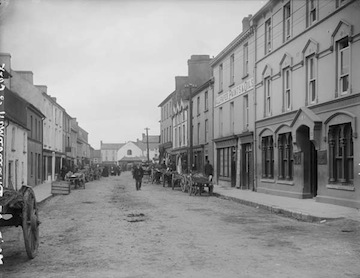
A busy Main Street, Dunmanway, Co. Cork. It was here that Sam Maguire, after whom the All-Ireland senior football championship is named, was born in 1879.
(NLI, LROY 10975)
One of the stalwart hurling areas of Cork was Blackrock. This was the home to 10-year old Eugene ‘Eudie’ Coughlan who went on to become one of the most famous Cork hurlers of all-time. His father, Pat, was a fisherman who had won All-Irelands in the 1890s. His uncles Denis 'Lyonsie' Coughlan, Jer Coughlan, Dan Coughlan and Tom ‘Honest Man’ Coughlan also played with Blackrock club. Young Eudie picked mussels from the River Lee for export to England and later worked for the Ford motor company. It was his exploits as a hurler which won him fame, however, as he outstripped the achievements of his father, winning seven Cork senior championships and four All-Ireland championships.

Cork captain, Eudie Coughlan kisses the ring of Dr. Hayden, Archbishop of Hobart, prior to the first replay of the 1931 All-Irelan hurling final. Coughlan, one of the greatest hurlers of his time, came from a family of fishermen from Blackrock and was 10 years old in 1911
(GAA Oral History Project)
There was a thriving, long-established cricket scene in Cork. The Cork County Cricket Club, on the Mardyke, had been founded in 1874, and played a regular calendar of fixtures. In 1903 the most important Victorian sportsman, W.G. Grace, the English cricketer, brought his touring team to play an Irish team in Cork as part of the international exhibition. Grace was out for one in the first over of the match, but attempted to bully his way to staying in, until the local cricket grandee, Sir George Colthurst of Blarney intervened and told Grace to leave the field. The following season South Africa visited Cork and were beaten by Ireland.
Soccer was also played in the city, though not at anything approaching the levels of the other urban areas of Dublin and Belfast. Unlike rugby, the game did not take root in Queen’s College, Cork (later University College, Cork). There was, however, a club based around the British Army garrison in Cork city, called Barrackton Rovers AFC. In 1909 a team representing the English second division side, Manchester City, played against a Munster Selection in Cork. In the 1920s when Fordsons, a team based in the Ford Motor Company, began to compete in the Irish Free State League, soccer finally began to advance in the city.

The Garrison game: a soccer match at the Admiralty Recreation Ground, Castletown, Berehaven, Co. Cork.
(NLI, LROY 08952)
While soccer was ultimately to become the most international of all sports, road bowling was an intensely local affair in Cork. It was a vibrant part of local culture and one of its greatest players, Tim Delaney, is immortalised in the famous Cork song ‘The Boys of Fairhill’. In the early years of the twentieth century, the greatest road bowler in Cork was John ‘Buck’ McGrath of Commons Rd., who worked as a clerk in Murphy’s brewery. An oil painting of McGrath hangs in the Bowlers’ Rest public house on the Mallow Road in Cork.
At the Cork Golf Club, laid out at Rathcooney Hill, just above Glanmire Village, David Brown was employed as a professional and he made clubs which he sold to visiting and resident golfers.
Sport was, of course, just one aspect of leisure life in Cork in 1911. There were two major breweries in Cork: Murphy’s, and Beamish and Crawford. Beamish (see return for Director Ludlow Beamish) and Crawford was established in 1792 by William Beamish and William Crawford, while Murphy’s was established in 1856. Both breweries were best known for their stout. The pubs of Cork were lively and ubiquitous, including that of Mary Jane Dillon on Wolfe Tone Square in Bantry. The famous Cork Pipers’ Club was founded in 1898, and amongst the founding members were Sean Wayland and Alderman William Phair, who lived at Connaught Avenue. Among a new generation of pipers fostered by the club was Mollie Morrissey from Ballyclogh.

Fair Day, Bantry, Co. Cork, ca. 1900
(NLI LROY 8798)
The rise in nationalist culture had brought about the establishment of the Cork Dramatic Society by Terence MacSwiney (see return in Irish for Blackrock) and Daniel Corkery of Bishopstown.

Memorial Card for Terence McSwiney
(http://www.corkcity.ie/media/terencemcswiney.jpg)
There was also a long tradition of socialising amongst the military in Cork. Around Victoria Barracks, for example, there were concerts and dancing, as well as the tradition of entertaining at home. Organisations such as the Royal Cork Institution (1803) were an attempt to mirror the Royal Dublin Society and the Royal Society. Other nineteenth century bodies included the Cork Society for Promoting the Fine Arts and the Cork Art Union that replaced it in the 1840s. The Cork Opera House was opened as the Athenaeum in 1855 and was built with the profits of the 1852 exhibition. It was not to become the Opera House until September 1877. The Cork Archaeological and Historical Society was founded as early as 1891. The Crawford School of Art and Gallery dates back to the 1880s and the Cork School of Music to 1878.

